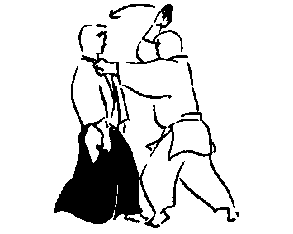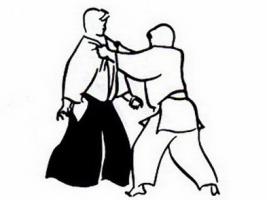|
When we talk about chokes we need to overcome our initial fear of the attack and remember what we have learned. For me Aikido is about remaining in control even when it seems like you are not and this is very important when dealing with chokes.
When looking at this specific choke, which is with one arm, you want to focus on weakest point. Which in this case is the hand/wrist, as it is farthest from the body. As the hand/wrist comes closer to the attackers body it becomes stronger and requires more strength to manipulate. Below are some videos that show this from a static perspective. We had some challenges so forgive the quality. The month of April we are going to be looking at a choke and it's impact on your ability to perform arts. Definition
Kubishime Kubishime Arts are the result of neck lock or choke from Uke. Breakdown Kubi - Neck Shime - Lock or choke Pronunciation ku-bee-she-mae Sorry about not updating, March was a crazy month for work and home life balance. Last month we worked on creating continuous movement through the concepts of Henka-waza and Kaeshi-waza. Keeping our movements dynamic and trying not to get into a static position that will require us to pit strength against strength.
Definition Henka-waza Henka-waza Arts start with one intent but vary to another based on the reaction of the Uke. Breakdown Henka - Variation Waza - Technique or method Pronunciation Hen-kah-waa-zah Definition Kaeshi-waza Kaeshi-waza Arts are reversal or escaping techniques that Nage applies when Uke is performing the Art. Breakdown Kaeshi - Both Waza - Technique or method Pronunciation Ki-ee-she-waa-zah
Enso Dojo, Sensie Bruce Webb and Sensei Chris Simonson
Below are the sessions where Sensei Chris Simonson shared some of their unique perspective on Aikido techniques. I love practicing with these gentlemen as I feel they are always challenging the approach to conflict with their experience from the military, wrestling, and life in general. Session 1Session 2Session 3Session 4Session 5Session 6Session 7Session 8
This week we are taking more of what we learned about the various types of two handed grabs, ryo-kata-tori, and our one hand grab and then strike, kata-tori men-uchi. When we think about a single opponent these attacks have a defined defense and counter into an art. With multiple attackers you are not just thinking about the first opponent that is attacking you but the next and then the one after that.
We have been working on lines to help us work through multiple attackers and focus on blocking each attackers potential attack. This week we are going to add to that in that we want to position our next attacker so that it is in our favor. On Saturday we talked that we want to maintain the multiple attackers into a manageable group so that we are seeing them as one large entity versus individual attackers. If we push one too hard and they are able to "break away from the pack", they become more of an unknown and they can either rejoin the group or attack on their own. Instead we want to keep the group moving together until we decide who we want to start picking off those we want or help arrives. I relate this a lot to how sardines are managed by predators, we want to become the predators and our attackers sardines. So I am a little behind this week, I was reminded how old I was after participating at the Valentines Fellowship Seminar hosted by Aikido Omaha. It was a great time practicing with those I haven't seen in a while and to gain new perspectives on techniques shared by so many awesome instructors. I tried to take video of every session and will try and intermix them over the next couple of weeks as we continue to work on the concept of Randori, multiple attackers. Kata-tori Men-uchi - Two attacks in oneAgain following the assumption that someone will not just stay in one place if there are multiple people try to attack them, the attacker will try and incorporate some kind of grab so they know where they are. So this week we are going to transition from a two handed grab to a single handed grab with a strike. There are many different ways the strike could happen, but for practicing we are going to focus on an over hand strike to the head. (which is also conveniently on an upcoming test)
So we started out this weekend working on Ryo-kata-tori, two hand shoulder grab. The main take away that we are going to focus on is the up/down movement of the hands as we are stepping forward moving our opponent to the opposite side of our forward movement. As we look at this being applied to Randori, our goal is to get rid of the current attacker as quickly as possible so we can move to the next. If we get bogged down on one attacker the others can circle around us and get us from behind to take us to the ground. You will hear me say a lot this month to keep moving. I will try and get some videos posted by Thursday demonstrating the static Ryo-kata-tori attack along with how I would like you to apply it during a Randori scenario.
As we finish up the month of January and all of the Ushiro Tekubi-tori arts that we worked on, we look forward to the month of February where we will look at what occurs when you have multiple attackers. Randori, Jiyu waza, or taninzu-gake is described as the practice of defending against multiple attackers without knowing how they will attack or in what order, all of this happening in quick succession. As I think about Randori, I try and look at it from the attackers prospective first. Then what do I think would work as an attack. First, I would make an assumption that the person being attacked by multiple people would likely not stay in the same place. So if they are moving, me being an attacker and I didn’t have a weapon, I would more than likely need to perform some type of grab as part of my attack to make sure I was actually going to hit them instead missing them entirely. So this narrows down the attacks to things like Kata-tori Men-uchi, Ryo-kata-tori, Kata-tori, or even wrist grabs. Randori via Ryo-kata-toriSo starting this weekend we will begin looking at Ryo-kata-tori, two hand grab to two shoulders and then we will progress from there to get us to Randori.
So this past week we have been making our movements more dynamic; moving with our attacker and blending into the movements. We talked about us being in control during the attack and how the position of our hand begins to dictate the direction that our attacker is moving. This week we will look at using the Ushiro Tekubitori as our foundation and show that we are capable to apply it to most types of Ushiro, grabs from behind.
Ushiro Tekubitori BlendingUshiro Tekubi-tori Leading HandUshiro Tekubi-tori Controlling your Attacker
As we continue working on our Ushiro Tekubi-tori arts adding some more variations on those that we learned in previous weeks. This week will be focused on a forward movement versus stepping backwards into our opponent; performing most of the same arts as in the previous weeks we will look at how the arts evolve by changing our initial approach to stepping forward than backwards.
As promised, I have some videos describing the first couple of arts, along with a discussion around the basic backward movement we started with. It's apparent that we need a tripod to make these better, but we are trying and we can only go up from here. :)
Ushiro Tekubi-tori BasicsUshiro Tekubi-tori IkkyoUshiro Tekubi-tori NikkyoUshiro Tekubi-tori Sankyo |
AuthorSensei Todd Dodson has been practicing Aikido for over 18 years and is affiliated with Aikido Hawaii International (AHI), chaired by Kaulukukui Sensei, through Sarpy Aikido Club in Omaha, Nebraska, chaired by Christenham Sensei . CategoriesArchives |


 RSS Feed
RSS Feed